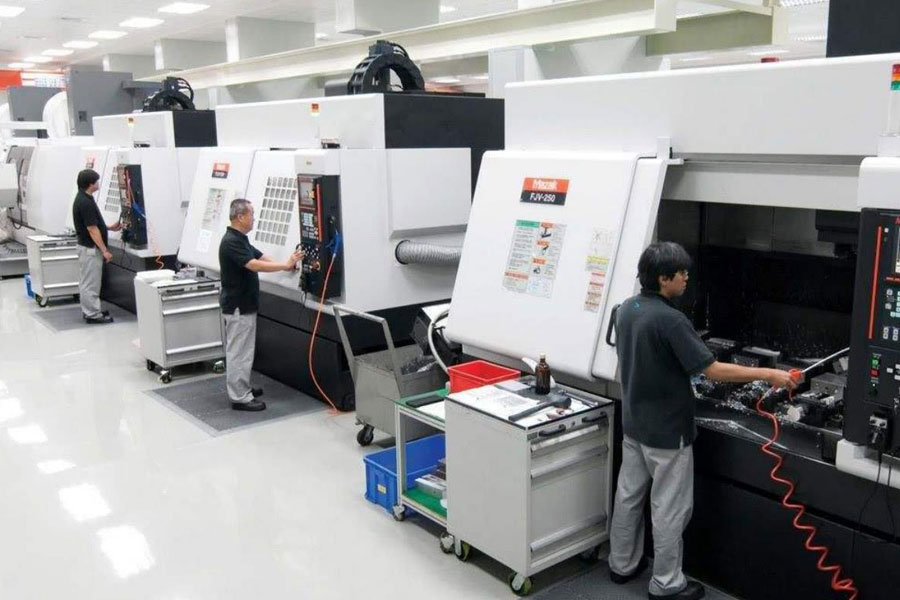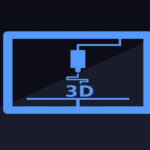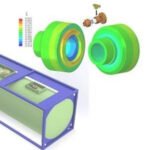Today, a new wave of innovation in the industrial revolution represented by the Internet is emerging around the world. The core of the change is also the application of a new generation of information technology such as the Internet. When new forms began to be injected into the manufacturing field, a new challenge also began, that is, the challenge of turning the manufacturing industry from mechanization, electrification, and digitization to networking, digitization, and intelligent manufacturing.
The backward human labor has been unable to meet the needs of modern manufacturing. Some developed countries have begun to invest in automation technology to improve productivity very early. As a result, in recent decades, with the informatization, digitization and networking of various products, the production structure of the manufacturing industry itself has become more complex, finer, and more automatic. The information flow inside the production line and production equipment, as well as the data for management work has increased sharply, and the previous automated systems have been unable to meet the higher demands of the manufacturing industry in terms of information processing capacity, efficiency and scale. The application of a new generation of information technology has solved this problem to a certain extent.
Today, a new wave of innovation in the industrial revolution represented by the Internet is emerging around the world. The core of the change is also the application of a new generation of information technology such as the Internet. When new forms began to be injected into the manufacturing field, a new challenge also began, that is, the challenge of turning the manufacturing industry from mechanization, electrification, and digitization to networking, digitization, and intelligent manufacturing.

(1) Law: the evolution from industrialization to intelligentization
Table of Contents
The technical feature of traditional industrialization is the use of mechanization, electrification and automation to achieve mass production and mass sales. In the current complex international competition and the Chinese environment, in order to enhance the position of Chinese manufacturing in the global industrial value chain and solve the problem of large but not strong manufacturing, it is necessary to transform from traditional production methods to intelligent production methods.
The technical characteristics of modern industrialization, in addition to physical systems (mechanization, electrification, automation), but also through the integration of information systems (computerization, informationization, networking), and finally realize cyber-physical systems (intelligence). In the “Industry 4.0” era, China’s manufacturing industry is developing towards intelligence, and there is huge space and potential. At present, China is in the process of industrialization, and the rise of the economy must first rely on manufacturing. While the new round of industrial revolution brings many challenges, it will also provide many rare “opportunities” for China’s new round of manufacturing development. Because historical experience has shown that every industrial revolution provides “opportunities” for late-developing countries to succeed in catching up. Britain, Germany, the United States, and Japan all succeeded by seizing the opportunities of the industrial revolution. As far as the transformation and upgrading of China’s manufacturing industry is concerned, the new round of industrial revolution will also bring “opportunities” to catch up with and surpass development.
In the past, China’s manufacturing industry had low technological content and was always at the low end of the international industrial value chain. The deep integration of industry and information has effectively laid a solid foundation for the networked and intelligent development of manufacturing. There is no doubt that in the era of “Industry 4.0”, a new round of industrial revolution will more rapidly drive the in-depth integration of the two industrializations. The full embedding of information technology into the manufacturing industry will break the traditional production process, production mode and management method. The in-depth integration of the manufacturing process and the business management system will realize a highly flexible configuration of production elements and realize mass customized production. Thus, it will effectively promote the traditional manufacturing industry to accelerate the pace of transformation and upgrading.
(2) Law: internal and external network collaboration
“Industry 4.0” defines the network collaboration structure between manufacturers, suppliers and even developers. The main purpose is to realize the collaboration of market and R&D, R&D and production, and management and communication, thereby forming a complete manufacturing network. , Composed of multiple manufacturing companies or participants, they exchange goods and information with each other, and jointly execute business processes. The three dimensions of enterprise, value chain and product life cycle run through the manufacturing participants in each value chain. At the top are management functions, and at the bottom are manufacturing functions.
At the same time, the “smart production” of the “smart factory” focuses on the study of intelligent production systems and processes, as well as the realization of networked distributed production facilities. The core is the application of the entire industrial production process through the cyber-physical system (CPS) , Use the technology of the Internet of Things, software technology and communication technology to strengthen information management and services, and improve the controllability of the production process, so as to achieve a full range of information coverage of R&D, production, manufacturing process and industrial control, and comprehensive control of various information , To ensure that all production and manufacturing links can be in the optimal state. Thereby guiding the manufacturing industry to transform to intelligence.
1. Internal network collaborative manufacturing
For a manufacturing company, its internal information is based on manufacturing, including production management, logistics management, quality management, equipment management, personnel and working hours management and other production-related elements. Traditional manufacturing management is based on a single workshop/factory as the management unit. The focus of management is production, and the scope of management is within the manufacturing industry.
However, with the advancement of information technology, many manufacturing enterprises in different periods of development, according to the needs of different periods of management, continue to develop different systems, and gradually use them within the enterprise, such as inventory management system, production management system , Quality Management System, Product Life Cycle Management System, Supply Management System, etc. Different systems implement different functions, and some systems are composed of self-developed systems or systems from different suppliers. With the development of enterprises, coordination between management of different production elements is required to avoid information islands in the manufacturing process. Therefore, the demand for interfaces and compatibility between various systems is getting higher and higher, that is, between various systems. The internal synergy is becoming more and more important.
In particular, as the requirements for manufacturing agility and lean manufacturing continue to increase, relying on manual import and export of information can no longer meet the needs of manufacturing informatization, which requires network collaboration between different systems to achieve real-time information Deliver and share.
2. External network collaborative manufacturing
In the future manufacturing industry, each factory will operate independently. Each factory has an independent production management system, or adopts a set of production management system to manage all factory operations. However, with the development of the enterprise, the enterprise has set up different production bases and multiple factories. The factories often need to dispatch each other to make rational use of resources such as manpower, equipment, and materials. The information flow between each factory in the enterprise is greater. More and more, real-time requirements are getting higher and higher, and at the same time, the data volume and execution speed of each factory are getting higher and higher. This requires network collaboration between different factories to ensure real-time information transmission and sharing.
In the era of globalization and the Internet, collaboration is not only the collaboration within the organization, but also often involves the collaboration between upstream and downstream organizations in the industrial chain. On the one hand, through network collaboration, consumers and manufacturing companies jointly carry out product design and research and development to meet individual customization needs; on the other hand, through network collaboration, configure raw materials, capital, equipment and other production resources to organize dynamic manufacturing. Shorten the product development cycle to meet the needs of differentiated markets.
Horizontal integration in “Industry 4.0” represents the integration of production systems, which is an integration of the entire industry chain. In the past factory production, the production of products or parts was just an independent process, without any connection between them, and no further logical control. External network collaborative manufacturing enables a factory to produce only part of a certain product according to its own production capacity and production schedule, and the entire industrial chain of external logistics, external factory production, and sales can be linked. In this way, horizontal industrial integration in the value chain is realized.
(3) Future manufacturing: shorten construction period, reduce costs, improve efficiency, meet customization, and reduce energy consumption
With the popularization of information technology, the Internet, and e-commerce, the new requirements of manufacturing market competition have changed. On the one hand, manufacturing companies are required to continuously obtain information based on the Internet, and respond quickly to market demand in a timely and dynamic manner; on the other hand, manufacturing companies are required to dynamically integrate and share various resources, and make rational use of various resources. resource. Connected manufacturing can quickly respond to market changes, and quickly configure manufacturing resources through rapid reorganization and dynamic coordination of manufacturing enterprises, improve product quality, reduce the time required for product launches, and increase market share. At the same time, it can also share infrastructure construction costs, equipment investment costs, etc., and reduce operating risks. The integration of manufacturing resources has broken through the boundaries between enterprises and countries, and it is becoming possible to seek resources from a global scale based on the Internet. With the support of global economic integration and the Internet, logistics, capital flow, and information flow will break through regional restrictions and flow dynamically. , The world will enter an era of global interconnected manufacturing.
As a future trend, factories will realize the network of internal and external services through the Internet and the Internet of Things, and develop towards the trend of interconnected factories. Subsequently, collecting and analyzing all kinds of information in the production workshop, giving feedback to consumers, and analyzing the information collected from the factory as big data can open up more and new business opportunities. How to deal with the massive data collected from the workshop via hardware will also determine the value of services and solutions to a large extent. In other words, under the interconnected manufacturing model, manufacturing companies will no longer centrally control production from top to bottom, and will no longer engage in separate design and R&D links, or separate production and manufacturing links, or separate marketing and service links. Instead, it starts from customer demand, to accept product orders, seek cooperative production, purchase raw materials or parts, and jointly carry out product design, production and assembly. The entire link is connected through the Internet and communicated in real time to ensure that the final product meets large-scale customers. Personalized customization needs.
The ubiquitous Internet and convenient logistics system make the process of product research and development, design, production, sales and service not necessarily completed independently in a company or even in a country, but may be decomposed, outsourced, and crowdsourced. Different companies, even countries and regions. In the future, the strength of an enterprise’s competitiveness does not lie in how many resources and core technologies it has, but its ability to analyze information and data, to integrate resources, and to internationalize resources.
This degree of flexibility in production and manufacturing represents the future development direction of the manufacturing industry. It will enable companies to respond quickly and easily when facing changes in customer needs, and ensure that their production is competitive and meet the individual characteristics of large-scale customers. According to the needs of customized customization, the enterprise itself will realize the transformation and upgrading from pure manufacturing to “manufacturing + service”.
Boundlessness, universalization, informatization, and fast transmission speed are the characteristics of the Internet. Through the application of Internet technology in all aspects of the manufacturing industry, the connection between digital information and the physical reality is visualized, and the production process and management process are fully integrated to achieve “Internet +” collaborative manufacturing. In this way, it is possible to design and research, purchase raw materials and parts, organize production and carry out marketing at the same time, thereby reducing operating costs, improving production efficiency, shortening product production cycles, and reducing energy use.
Through the Internet and Internet of Things technology, the procurement, production, sales, transportation and other businesses of manufacturing companies and related spare parts companies and users are integrated on the network platform, which not only helps to promote the directness and transparency of business processes It will also improve efficiency and reduce transaction costs.
It can be said that the Internet and the Internet of Things have affected human society and played a great role in promoting social development. They are the biggest source of various changes facing society today. In the future, the manufacturing industry will use the Internet and the Internet of Things technology to make all links in the manufacturing value chain more closely connected and efficient collaboration, so that personalized products can be produced in a highly efficient mass-production manner to achieve so-called “mass customization.” Intelligent manufacturing in the future manufacturing industry will also cause major or even revolutionary changes in the product form, design and manufacturing process, management methods and organizational structure, manufacturing mode, and business model of the manufacturing industry, and drive major changes in human life style.
Link to this article:The Characteristics Of Industry 4.0: Evolution From Industrialization To Intelligentization
Reprint Statement: If there are no special instructions, all articles on this site are original. Please indicate the source for reprinting:https://www.cncmachiningptj.com/,thanks!
 3, 4 and 5-axis precision CNC machining services for aluminum machining, beryllium, carbon steel, magnesium, titanium machining, Inconel, platinum, superalloy, acetal, polycarbonate, fiberglass, graphite and wood. Capable of machining parts up to 98 in. turning dia. and +/-0.001 in. straightness tolerance. Processes include milling, turning, drilling, boring, threading, tapping, forming, knurling, counterboring, countersinking, reaming and laser cutting. Secondary services such as assembly, centerless grinding, heat treating, plating and welding. Prototype and low to high volume production offered with maximum 50,000 units. Suitable for fluid power, pneumatics, hydraulics and valve applications. Serves the aerospace, aircraft, military, medical and defense industries.PTJ will strategize with you to provide the most cost-effective services to help you reach your target,Welcome to Contact us ( [email protected] ) directly for your new project.
3, 4 and 5-axis precision CNC machining services for aluminum machining, beryllium, carbon steel, magnesium, titanium machining, Inconel, platinum, superalloy, acetal, polycarbonate, fiberglass, graphite and wood. Capable of machining parts up to 98 in. turning dia. and +/-0.001 in. straightness tolerance. Processes include milling, turning, drilling, boring, threading, tapping, forming, knurling, counterboring, countersinking, reaming and laser cutting. Secondary services such as assembly, centerless grinding, heat treating, plating and welding. Prototype and low to high volume production offered with maximum 50,000 units. Suitable for fluid power, pneumatics, hydraulics and valve applications. Serves the aerospace, aircraft, military, medical and defense industries.PTJ will strategize with you to provide the most cost-effective services to help you reach your target,Welcome to Contact us ( [email protected] ) directly for your new project.
Link to this article:The Characteristics Of Industry 4.0: Evolution From Industrialization To Intelligentization
Reprint Statement: If there are no special instructions, all articles on this site are original. Please indicate the source for reprinting.:Cnc Machining,Thank!^^








